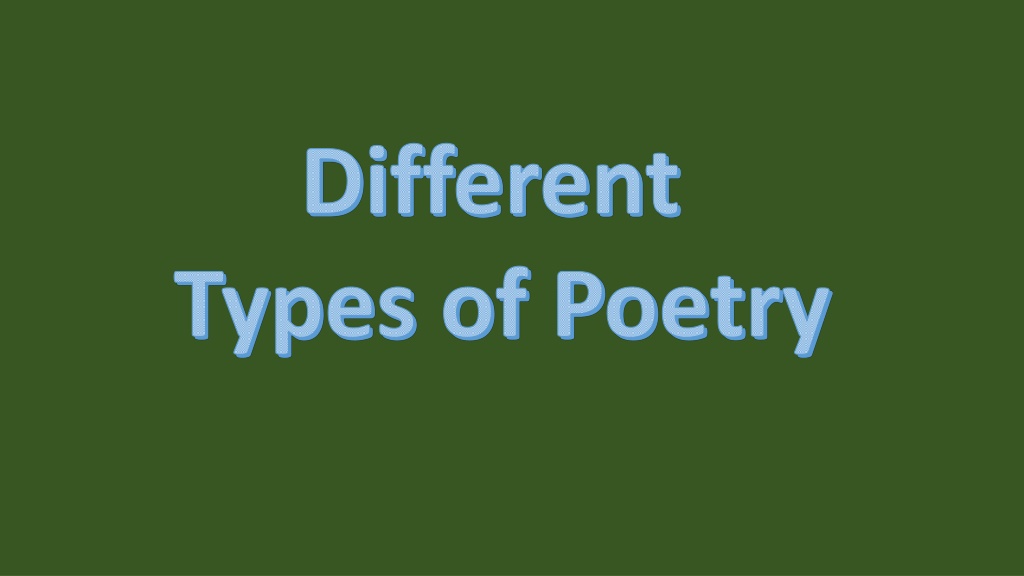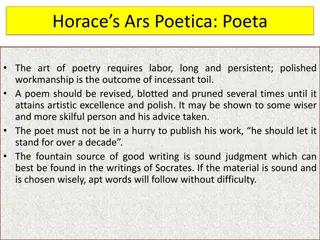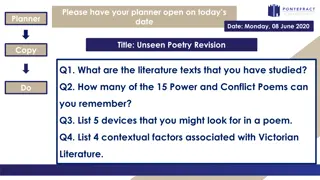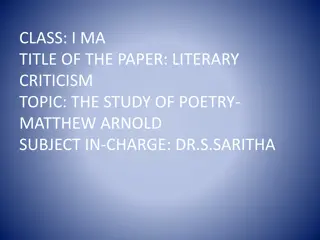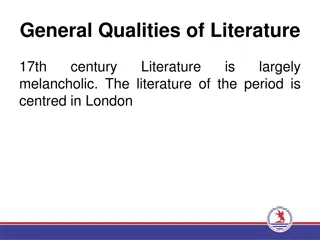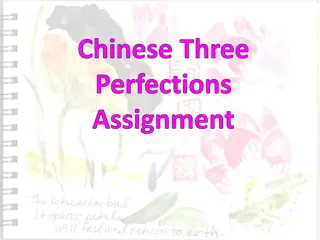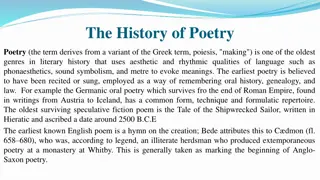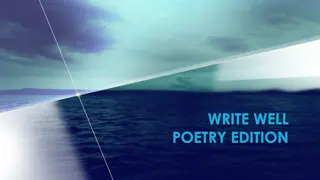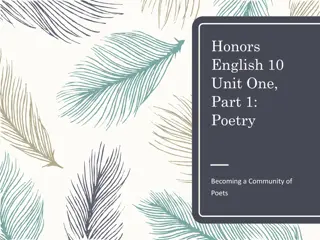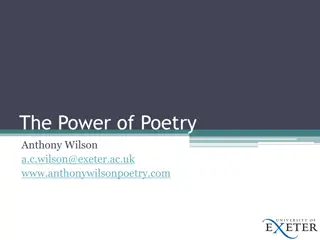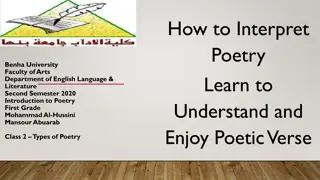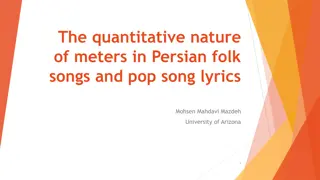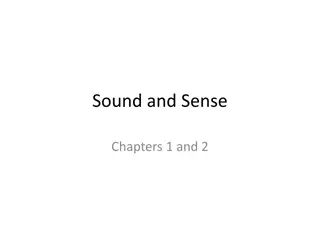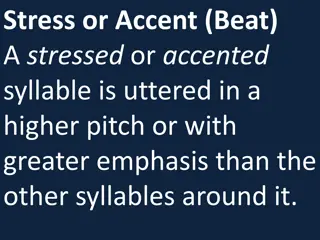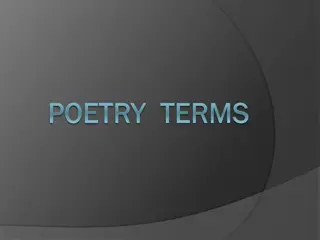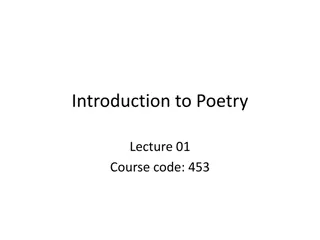Explore Various Types of Poetry in Today's Lesson
Dive into a comprehensive lesson on poetic terms, different types of poetry, and poetic techniques. Discover the beauty of stanzas, lines, rhyme schemes, and explore examples such as palindrome poems. Get ready for a thrilling Poetry Slam where you'll share your favorite style of poetry with the class!
Download Presentation

Please find below an Image/Link to download the presentation.
The content on the website is provided AS IS for your information and personal use only. It may not be sold, licensed, or shared on other websites without obtaining consent from the author. Download presentation by click this link. If you encounter any issues during the download, it is possible that the publisher has removed the file from their server.
E N D
Presentation Transcript
Different Types of Poetry
Agenda Today I will begin by reviewing poetic terms and several types of poetry. Once I have done this it will be your mission to look over the rest of the powerpoint on your own and determine which style of poetry looks the most interesting to you. By the end of the period, let me know what style of poetry you plan to use. BONUS: If you want to know more about the poem Annabel Lee, check out the detailed analysis PowerPoint in the same page you opened these instructions from!
Poetry Slam! Poetry Slam! We will perform our poems individually to the whole class on Monday. Project your voice loud and clap for your peers after each poem!
Poetry terms Consonance Assonance Alliteration Internal rhyme Slant rhyme/off rhyme Repetition Stanzas Lines Rhyme scheme Rhythm Theme Tone/mood symbols
Stanzas and Lines Stanzas Stanzas are like the paragraphs of poems. They are usually grouped together by the rhyme pattern and/or number of lines that they have. Lines ines are like the sentences of poems. They are a single set of words grouped together within a stanza
Example O CAPTAIN! my Captain! our fearful trip is done; The ship has weather'd every rack, the prize we sought is won; The port is near, the bells I hear, the people all exulting, While follow eyes the steady keel, the vessel grim and daring: But O heart! heart! heart! O the bleeding drops of red, Where on the deck my Captain lies, Fallen cold and dead.
CONSONANCE internal consonant sounds close proximity to one another sounds in Bless Bitt tten, matt tter Blood d shed, ss, curs se, chess ss, hiss ss, tes st, d, red d Assonance internal vowel sounds close proximity to one another vowel sounds in Go o, lo ow, elbo ow Re est, be est, depressed
Palindrome poems Palindromes are read the same forwards and backwards letter by letter. In some cases, such as Palindrome poetry, they can be forward and backward word by word, or sentence by sentence.
Contrast Poems A contrast poem takes a concept or them and approaches it from two drastically different perspectives. Pick any poem you have written so far and reread it carefully. Now, set about writing something that could be the thematic opposite of the original work. Write this on a loose sheet of paper. Ex. The first poem was about a young man finding love, the second is about an old woman losing it. In both, the subject is still love, simply different aspects of it.
The Tiger TIGER, tiger, burning bright In the forests of the night, What immortal hand or eye Could frame thy fearful symmetry? The Lamb By William Blake Little Lamb who made thee Dost thou know who made thee Gave thee life & bid thee feed. By the stream & o'er the mead; Gave thee clothing of delight, Softest clothing wooly bright; Gave thee such a tender voice, Making all the vales rejoice! Little Lamb who made thee Dost thou know who made thee In what distant deeps or skies Burnt the fire of thine eyes? On what wings dare he aspire? What the hand dare seize the fire? And what shoulder and what art Could twist the sinews of thy heart? And when thy heart began to beat, What dread hand and what dread feet? What the hammer? what the chain? In what furnace was thy brain? What the anvil? What dread grasp Dare its deadly terrors clasp? Little Lamb I'll tell thee, Little Lamb I'll tell thee! He is called by thy name, For he calls himself a Lamb: He is meek & he is mild, He became a little child: I a child & thou a lamb, We are called by his name. Little Lamb God bless thee. Little Lamb God bless thee. When the stars threw down their spears, And water'd heaven with their tears, Did He smile His work to see? Did He who made the lamb make thee? Tiger, tiger, burning bright In the forests of the night, What immortal hand or eye Dare frame thy fearful symmetry?
Big List of Poetic Terminology Alliteration Apostrophe Literary Term Caesura Literary Term Denotation Literary Term Epithet Literary Term Falling Meter Foot Literary Term Hexameter Literary Term Iambic pentameter Meter Literary Term Onomatopoeia Persona Literary Term Rising Meter Literary Term Spondee Literary Term Tetrameter Anapaest Literary Term Archetype Literary Term Consonance Elision Literary Term Euphony Feminine Rhyme Heptameter Hyperbole Litotes Literary Term Meiosis Literary Term Paradox Literary Term Quatrain Scansion Literary Term Stanza Trochee Literary Term Antithesis Assonance Literary Term Connotation Literary Term Envoy Literary Term Euphemism Figure of speech Heroic couplet Iamb Literary Term Metaphor Metonymy Pentameter Rhythm Simile Syntax Literary Term Trope Literary Term
ABC poem Alexandrine Poetry Type Allegory Analogy Poetry Type Ballad Poems Ballade Poetry Types Blank Verse Burlesque Types Cacophony Canzone Poetry Type Carpe diem Cinquain Poetry Type Classicism Types Conceit Poetry Type Couplet Poetry Type Dactyl Poetry Type Enjambment Epitaph Haiku Poetry Type Irony Lyric Poetry Doggerel Epic Poems Epithalamium Form Idyll Poetry Types Lay Poetry Types Name Poem Elegy Epigram Free Verse Imagery Poems Limericks Narrative Poetry Odes Pastoral Poetry Type Quatrain Poetry Type Refrain Poetry Type Senryu Poetry Type Tanka Rhymes Rhyme Royal Type Terza rima Prose and Prose Poetry Romanticism Type Sonnets Verse
What is an acrostic poem? An acrostic poem uses the letters in a topic word to begin each line. All the lines of the poem should relate to or describe the topic word.
Acrostic Example Sometimes hard work Can be stressful Homework never-ending On weekdays, Seven to three Only for twelve years Leave to start again in college
Riddle poem A riddle poem is a poem with a mystery built in, typically with a specific answer to said mystery. Who am I? I am bright then the morning star when I come down destruction follows the death rises as I get louder you quake at my might a bright flash followed by a loud bang so flash, flash, flash my power comes down lives crumble And They All Fall Down! Ryan Albert
Epitaph A short poem, saying or other message on a gravestone in memory of a deceased person. EX: For Mary Fowler, 1792, age 24, Milford, CT Molly tho pleasant in her day Was suddenly seized and went away How soon she s ripe, how soon she s rotten Laid in her grave and soon forgotten.
Quatrain Poems Quatrains are four line poems that may follow any of one of the four different rhyme schemes. (ABAB, AABB, ABBA, ABCA) When Quatrains begin to make up a long poem the quatrains are then called stanzas. EX. The rushing ocean waves Beat harshly on the sand. They roar and crash and foam As they break upon the land.
The Sonnet The word sonnet means a little sound or song . A sonnet is a highly-structured 14 line poem that explores deeply felt issues such as the fleeting nature of love and the aching questions of mortality. A traditional sonnet has 14 lines, each of which is written in iambic pentameter. That is each line has 5 metric units or feet, and each foot consists of an unstressed syllable followed by a stressed syllable.
Blank Verse Blank Verse is poetry that is written in unrhymed iambic pentameter. Example Tomorrow, and tomorrow, and tomorrow, Creeps in this petty pace from day to day, To the last syllable of recorded time; And all our yesterdays have lighted fools The way to dusty death. Out, out, brief candle! Life's but a walking shadow, a poor player That struts and frets his hour upon the stage And then is heard no more: it is a tale Told by an idiot, full of sound and fury, Signifying nothing. - Excerpt from Macbeth by William Shakespeare
Bio Poem Example Template: Tom Line 1: First Name Line 2: 4 Descriptive Traits Line 3: Sibling of Line 4: Lover of Line 5: Who fears Line 6: Who need Line 7: Who gives Line 8: Who would like to see Line 9: Resident of Line 10: Last Name Tall, Tasty, Feathery, Vicious A bio poem is used to focus on the characteristics of a person or animal. Sibling of Clucky Chicken and Big Bird, Lover of vegetarians and ham eaters, Fears Mr. Butterball and pilgrims, Needs to run around, Gives nourishment and left overs, Would like to see birds unite and revolt, Resident of Old MacDonald s Farm, Turkey
Concrete Poetry Poetry in which authors use both words and physical shape to convey a message.
Another Concrete Poem Another Concrete Poem
Poetry Resources Page Helpful Links for you! Types of Poems http://www.tqnyc.org/NYC030240/typesofpoems.html Samples of Narrative Poetry http://www.babincentral.com/7english/narrative _poetry.htm Lyrical Poetry www.lyrics.com Finding Poetry www.poemhunter.com
